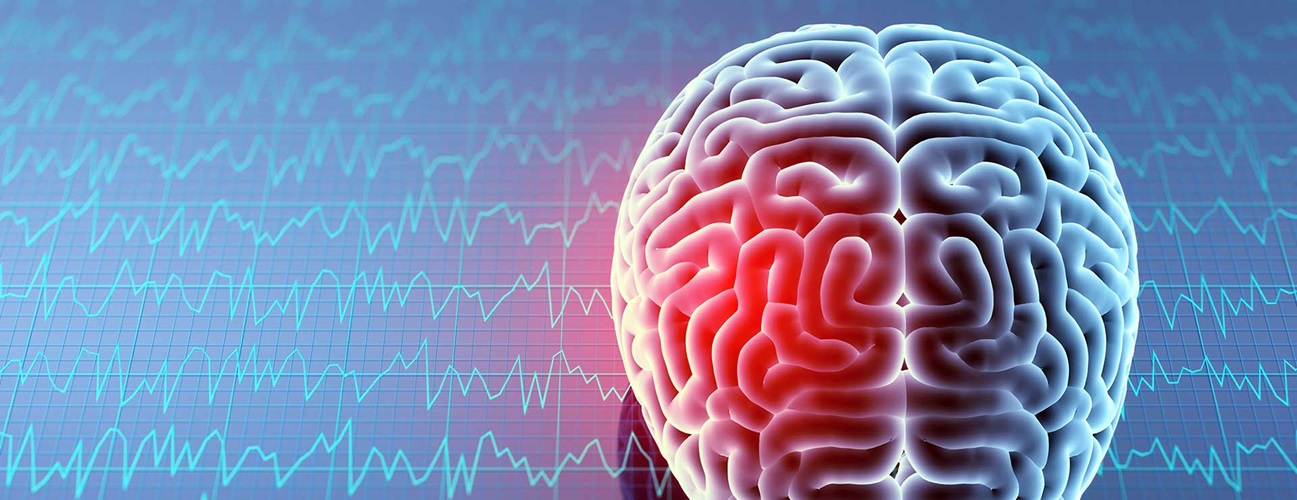Traumatic Brain Injury
What is traumatic brain injury?
Traumatic brain injury (TBI) happens when a sudden, external, physical assault damages the brain. It is one of the most common causes of disability and death in adults. TBI is a broad term that describes a vast array of injuries that happen to the brain. The damage can be focal (confined to one area of the brain) or diffuse (happens in more than one area of the brain). The severity of a brain injury can range from a mild concussion to a severe injury that results in coma or even death.
What are the different types of TBI?
Brain injury may happen in one of two ways:
-
Closed brain injury. Closed brain injuries happen when there is a nonpenetrating injury to the brain with no break in the skull. A closed brain injury is caused by a rapid forward or backward movement and shaking of the brain inside the bony skull that results in bruising and tearing of brain tissue and blood vessels. Closed brain injuries are usually caused by car accidents, falls, and increasingly, in sports. Shaking a baby can also result in this type of injury (called shaken baby syndrome).
-
Penetrating brain injury. Penetrating, or open head injuries happen when there is a break in the skull, such as when a bullet pierces the brain.
What is diffuse axonal injury (DAI)?
Diffuse axonal injury is the shearing (tearing) of the brain's long connecting nerve fibers (axons) that happens when the brain is injured as it shifts and rotates inside the bony skull. DAI usually causes coma and injury to many different parts of the brain. The changes in the brain are often microscopic and may not be evident on computed tomography (CT scan) or magnetic resonance imaging (MRI) scans.
What is primary and secondary brain injury?
Primary brain injury refers to the sudden and profound injury to the brain that is considered to be more or less complete at the time of impact. This happens at the time of the car accident, gunshot wound, or fall.
Secondary brain injury refers to the changes that evolve over a period of hours to days after the primary brain injury. It includes an entire series of steps or stages of cellular, chemical, tissue, or blood vessel changes in the brain that contribute to further destruction of brain tissue.
What causes a head injury?
There are many causes of head injury in children and adults. The most common injuries are from motor vehicle accidents (where the person is either riding in the car or is struck as a pedestrian), violence, falls, or as a result of shaking a child (as seen in cases of child abuse).
What causes bruising and internal damage to the brain?
When there is a direct blow to the head, the bruising of the brain and the damage to the internal tissue and blood vessels is due to a mechanism called coup-contrecoup. A bruise directly related to trauma at the site of impact is called a coup lesion (pronounced COO). As the brain jolts backward, it can hit the skull on the opposite side and cause a bruise called a contrecoup lesion. The jarring of the brain against the sides of the skull can cause shearing (tearing) of the internal lining, tissues, and blood vessels leading to internal bleeding, bruising, or swelling of the brain.
What are the possible results of brain injury?
Some brain injuries are mild, with symptoms disappearing over time with proper attention. Others are more severe and may result in permanent disability. The long-term or permanent results of brain injury may need post-injury and possibly lifelong rehabilitation. Effects of brain injury may include:
- Cognitive deficits
-
Coma
-
Confusion
-
Shortened attention span
-
Memory problems and amnesia
-
Problem-solving deficits
-
Problems with judgment
-
Inability to understand abstract concepts
-
Loss of sense of time and space
-
Decreased awareness of self and others
-
Inability to accept more than one- or two-step commands at the same time
-
- Motor deficits
-
Paralysis or weakness
-
Spasticity (tightening and shortening of the muscles)
-
Poor balance
-
Decreased endurance
-
Inability to plan motor movements
-
Delays in getting started
-
Tremors
-
Swallowing problems
-
Poor coordination
-
- Perceptual or sensory deficits
-
Changes in hearing, vision, taste, smell, and touch
-
Loss of sensation or heightened sensation of body parts
-
Left- or right-sided neglect
-
Difficulty understanding where limbs are in relation to the body
-
Vision problems, including double vision, lack of visual acuity, or limited range of vision
-
- Communication and language deficits
-
Difficulty speaking and understanding speech (aphasia)
-
Difficulty choosing the right words to say (aphasia)
-
Difficulty reading (alexia) or writing (agraphia)
-
Difficulty knowing how to perform certain very common actions, like brushing one's teeth (apraxia)
-
Slow, hesitant speech and decreased vocabulary
-
Difficulty forming sentences that make sense
-
Problems identifying objects and their function
-
Problems with reading, writing, and ability to work with numbers
-
- Functional deficits
-
Impaired ability with activities of daily living (ADLs), such as dressing, bathing, and eating
-
Problems with organization, shopping, or paying bills
-
Inability to drive a car or operate machinery
-
- Social difficulties
-
Impaired social capacity resulting in difficult interpersonal relationships
-
Difficulties in making and keeping friends
-
Difficulties understanding and responding to the nuances of social interaction
-
- Regulatory disturbances
-
Fatigue
-
Changes in sleep patterns and eating habits
-
Dizziness
-
Headache
-
Loss of bowel and bladder control
-
- Personality or psychiatric changes
-
Apathy
-
Decreased motivation
-
Emotional lability
-
Irritability
-
Anxiety and depression
-
Disinhibition, including temper flare-ups, aggression, cursing, lowered frustration tolerance, and inappropriate sexual behavior
Certain psychiatric disorders are more likely to develop if damage changes the chemical composition of the brain.
-
- Traumatic Epilepsy
- Epilepsy can happen with a brain injury, but more commonly with severe or penetrating injuries. While most seizures happen immediately after the injury, or within the first year, it is also possible for epilepsy to surface years later. Epilepsy includes both major or generalized seizures and minor or partial seizures.
Can the brain heal after being injured?
Most studies suggest that once brain cells are destroyed or damaged, for the most part, they do not regenerate. However, recovery after brain injury can take place, especially in younger people, as, in some cases, other areas of the brain make up for the injured tissue. In other cases, the brain learns to reroute information and function around the damaged areas. The exact amount of recovery is not predictable at the time of injury and may be unknown for months or even years. Each brain injury and rate of recovery is unique. Recovery from a severe brain injury often involves a prolonged or lifelong process of treatment and rehabilitation.
What is coma?
Coma is an altered state of consciousness that may be very deep (unconsciousness) so that no amount of stimulation will cause the patient to respond. It can also be a state of reduced consciousness, so that the patient may move about or respond to pain. Not all patients with brain injury are comatose. The depth of coma, and the time a patient spends in a coma varies greatly depending on the location and severity of the brain injury. Some patients emerge from a coma and have a good recovery. Other patients have significant disabilities.
How is coma measured?
Depth of the coma is usually measured in the emergency and intensive care settings using a Glasgow coma scale. The scale (from 3 to 15) evaluates eye opening, verbal response, and motor response. A high score shows a greater amount of consciousness and awareness.
In rehabilitation settings, here are several scales and measures used to rate and record the progress of the patient. Some of the most common of these scales are described below.
-
Rancho Los Amigos 10 Level Scale of Cognitive Functioning. This is a revision of the original Rancho 8 Level Scale, which is based on how the patient reacts to external stimuli and the environment. The scales consist of 10 different levels and each patient will progress through the levels with starts and stops, progress and plateaus.
-
Disability Rating Scale (DRS). This scale measures functional change during the course of recovery rating the person's disability level from none to extreme. The DRS assesses cognitive and physical function, impairment, disability, and handicap and can track a person's progress from "coma to community."
-
Functional Independent Measure (FIM). The FIM scale measures a person's level of independence in activities of daily living. Scores can range from 1 (complete dependence) to 7 (complete independence).
-
Functional Assessment Measure (FAM). This measure is used along with FIM and was developed specifically for people with brain injury.
The Brain Injury Rehabilitation Program
Rehabilitation of the patient with a brain injury begins during the acute treatment phase. As the patient's condition improves, a more extensive rehabilitation program is often begun. The success of rehabilitation depends on many variables, including the following:
-
Nature and severity of the brain injury
-
Type and degree of any resulting impairments and disabilities
-
Overall health of the patient
-
Family support
It is important to focus on maximizing the patient's capabilities at home and in the community. Positive reinforcement helps recovery by improving self-esteem and promoting independence.
The goal of brain injury rehabilitation is to help the patient return to the highest level of function and independence possible, while improving the overall quality of life— physically, emotionally, and socially.
Areas covered in brain injury rehabilitation programs may include:
- Self-care skills, including activities of daily living (ADLs): feeding, grooming, bathing, dressing, toileting, and sexual functioning
- Physical care: nutritional needs, medicines, and skin care
- Mobility skills: walking, transfers, and self-propelling a wheelchair
- Communication skills: speech, writing, and alternative methods of communication
- Cognitive skills: speech, writing, and alternative methods of communication
- Socialization skills: interacting with others at home and within the community
- Vocational training: work-related skills
- Pain management: medicines and alternative methods of managing pain
- Psychological testing and counseling: identifying problems and solutions with thinking, behavioral, and emotional issues
- Family support: assistance with adapting to lifestyle changes, financial concerns, and discharge planning
- Education: patient and family education and training about brain injury, safety issues, home care needs, and adaptive techniques
The Brain Injury Rehabilitation Team
The brain injury rehabilitation team revolves around the patient and family and helps set short- and long-term treatment goals for recovery. Many skilled professionals are part of the brain injury rehabilitation team, including any or all of the following:
-
Neurologist/neurosurgeon
-
Physiatrist
-
Internists and specialists
-
Rehabilitation nurse
-
Social worker
-
Physical therapist
-
Occupational therapist
-
Speech/language pathologist
-
Psychologist/neuropsychologist/psychiatrist
-
Recreation therapist
-
Audiologist
-
Dietitian
-
Vocational counselor
-
Orthotist
-
Case manager
-
Respiratory therapist
-
Chaplain
Types of Brain Injury Rehabilitation Programs
There are a variety of brain injury treatment programs, including the following:
-
Acute rehabilitation programs
-
Subacute rehabilitation programs
-
Long-term rehabilitation programs
-
Transitional living programs
-
Behavior management programs
-
Day-treatment programs
-
Independent living programs




